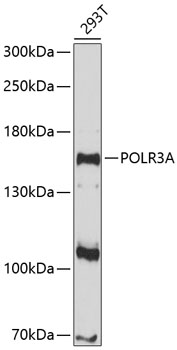-
Product Name
POLR3A Polyclonal Antibody
- Documents
-
Description
Polyclonal antibody to POLR3A
-
Tested applications
WB, IHC
-
Species reactivity
Human, Rat
-
Alternative names
POLR3A antibody; ADDH antibody; HLD7 antibody; RPC1 antibody; RPC155 antibody; hRPC155 antibody; RNA polymerase III subunit A antibody
-
Isotype
Rabbit IgG
-
Preparation
Antigen: Recombinant fusion protein containing a sequence corresponding to amino acids 1-200 of human POLR3A (NP_008986.2).
-
Clonality
Polyclonal
-
Formulation
PBS with 0.02% sodium azide, 50% glycerol, pH7.3.
-
Storage instructions
Store at -20℃. Avoid freeze / thaw cycles.
-
Applications
WB 1:500 - 1:2000
IHC 1:100 - 1:200 -
Validations

Western blot - POLR3A Polyclonal Antibody
Western blot analysis of extracts of 293T cells, using POLR3A antibody at 1:1000 dilution.Secondary antibody: HRP Goat Anti-Rabbit IgG (H+L) at 1:10000 dilution.Lysates/proteins: 25ug per lane.Blocking buffer: 3% nonfat dry milk in TBST.Detection: ECL Enhanced Kit .Exposure time: 90s.
-
Background
DNA-dependent RNA polymerase catalyzes the transcription of DNA into RNA using the four ribonucleoside triphosphates as substrates. Largest and catalytic core component of RNA polymerase III which synthesizes small RNAs, such as 5S rRNA and tRNAs. Forms the polymerase active center together with the second largest subunit. A single-stranded DNA template strand of the promoter is positioned within the central active site cleft of Pol III. A bridging helix emanates from RPC1 and crosses the cleft near the catalytic site and is thought to promote translocation of Pol III by acting as a ratchet that moves the RNA-DNA hybrid through the active site by switching from straight to bent conformations at each step of nucleotide addition (By similarity). Plays a key role in sensing and limiting infection by intracellular bacteria and DNA viruses. Acts as nuclear and cytosolic DNA sensor involved in innate immune response. Can sense non-self dsDNA that serves as template for transcription into dsRNA. The non-self RNA polymerase III transcripts, such as Epstein-Barr virus-encoded RNAs (EBERs) induce type I interferon and NF- Kappa-B through the RIG-I pathway.
Related Products / Services
Please note: All products are "FOR RESEARCH USE ONLY AND ARE NOT INTENDED FOR DIAGNOSTIC OR THERAPEUTIC USE"
